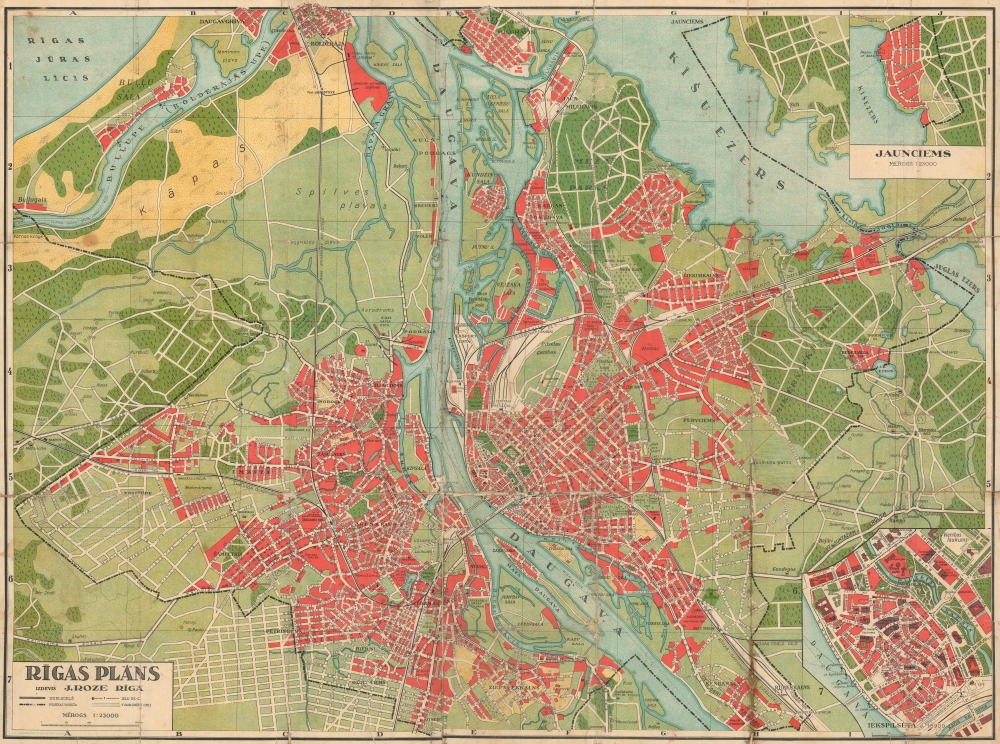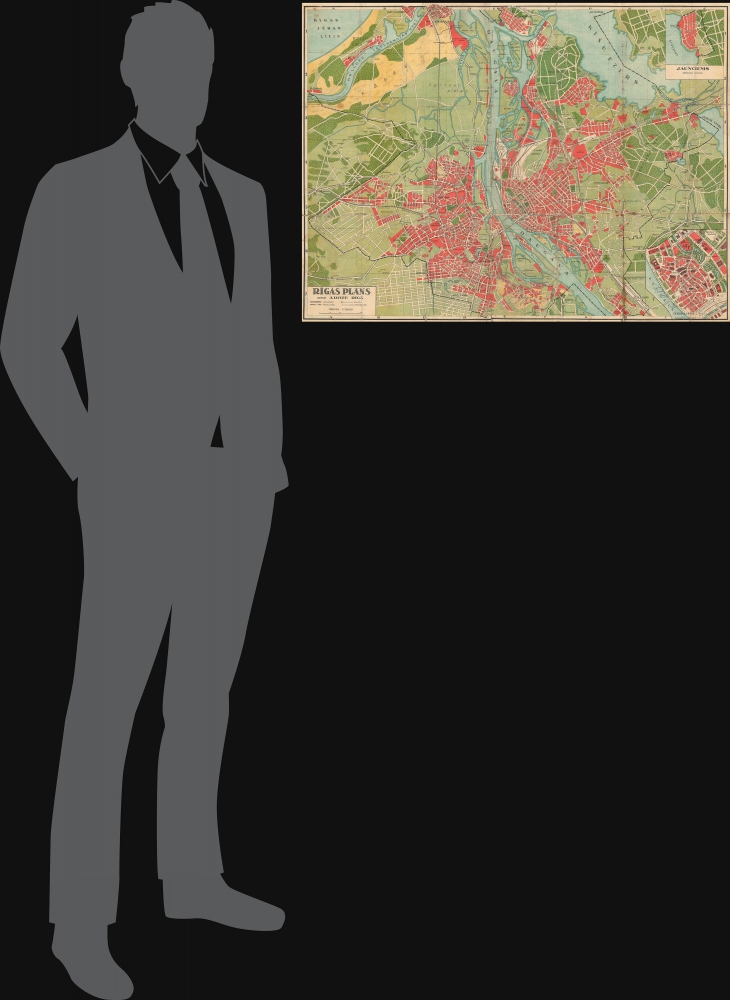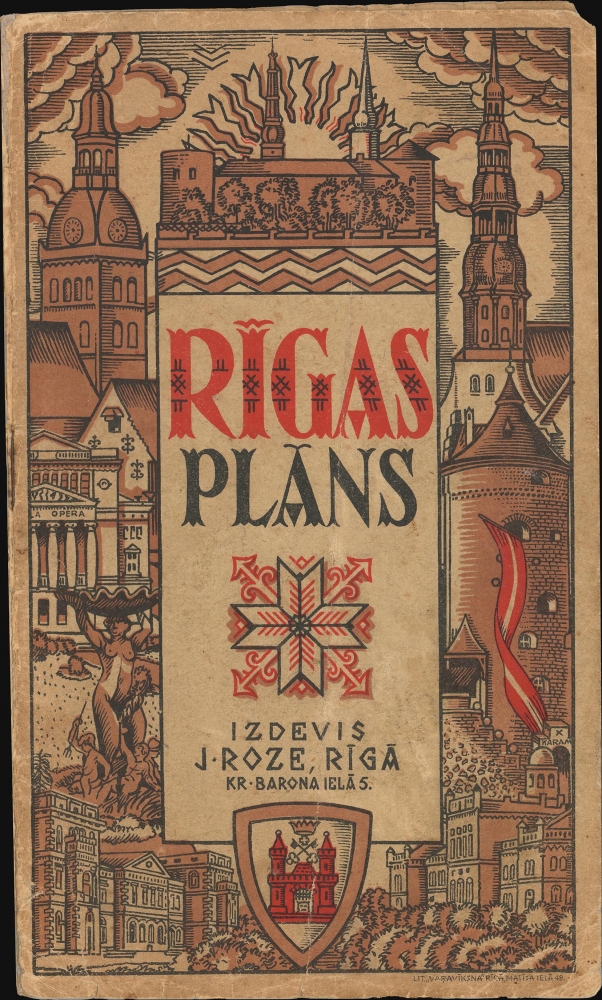This item has been sold, but you can get on the Waitlist to be notified if another example becomes available, or purchase a digital scan.
1940 J. Roze Map of Riga, Latvia - the last plan of pre-Soviet Riga
Riga-roze-1940
Title
1940 (undated) 25.75 x 34.75 in (65.405 x 88.265 cm) 1 : 23000
Description
A Closer Look
The map is large, unveiling Riga at a 1:23000 scale. Chromolithographed red blocks represent urbanization, while the surrounding light green areas indicate undeveloped zones, some of which are in the process of expansion, with ghosted, still-unnamed streets. Darker green represents parks and forests. Hundreds of individual businesses, institutions, and government offices are identified numerically throughout. These correspond to a 16-page index accompanying the map.Soviet Occupation of Latvia
In 1940, following the Molotov-Ribbentrop Pact between Nazi Germany and the Soviet Union, Latvia fell into the Soviet sphere of influence. In June 1940, Soviet forces occupied Riga, leading to the swift incorporation of Latvia into the Soviet Union. This occupation marked the end of Latvia's independence, which had been established after World War I (1914 - 1918). The Soviet authorities quickly imposed communist rule, resulting in the nationalization of property, suppression of political dissent, and widespread arrests and deportations of those considered enemies of the state. The year 1940 in Riga thus became synonymous with the loss of freedom and the beginning of a long period of Soviet domination that would last until the early 1990s.Chromolithography
Chromolithography, sometimes called oleography, is a color lithographic technique developed in the mid-19th century. The process uses multiple lithographic stones, one for each color, to yield a rich composite effect. Generally, a chromolithograph begins with a black basecoat upon which subsequent colors are layered. Some chromolithographs used 30 or more separate lithographic stones to achieve the desired effect. Chromolithograph color can be blended for even more dramatic results. The process became extremely popular in the late 19th and early 20th centuries when it emerged as the dominant method of color printing. The vivid color chromolithography made it exceptionally effective for advertising and propaganda.Publication History and Census
The map was designed and published by Janis Roze and printed in Riga by Litogrāfija Varavīksna. Most Roze maps date to the 1920s and 30s, but the present map's accompanying booklet bears a date of 1940. This is one of the last publications of J. Roze and of independent Latvia, as the company was nationalized and renamed later that year during the Soviet occupation. Janis himself was sent to Siberia, where he died of starvation. Rare. We see but one example in OCLC, at the Staatsbibliothek zu Berlin. [Šī ir iespaidīga liela mēroga aptuveni 1940 gada Rīgas, Latvijas karte, kuru izdevis Jānis Roze. Šī ir viena no pēdējām neatkarīgās Rīgas kartēm, kas izdota tajā pašā gadā, kad to pārņēma padomju vara, un visi uzņēmumi, tostarp J. Roze, tika nacionalizēti.Tuvākā apskate
Karte ir liela, attēlojot Rīgu mērogā 1:23000. Hromolitografētie sarkanie bloki apzīmē urbanizētās zonas, bet apkārtējās gaiši zaļās teritorijas norāda uz neattīstītām zonām, no kurām dažas vēl tiek paplašinātas ar ielu spokiem, kam vēl nav nosaukumu. Tumšāki zaļie laukumi apzīmē parkus un mežus. Karte numeriski norāda simtiem individuālu uzņēmumu, iestāžu un valdības biroju, kas atbilst 16 lappušu indeksam, kas pievienots kartei.Padomju okupācija Latvijā
1940, gadā, pēc Molotova-Ribentropa pakta starp nacistisko Vāciju un Padomju Savienību, Latvija nonāca padomju ietekmes sfērā. 1940 gada jūnijā padomju spēki okupēja Rīgu, kas noveda pie ātras Latvijas inkorporācijas Padomju Savienībā. Šī okupācija iezīmēja Latvijas neatkarības, kas tika izcīnīta pēc Pirmā pasaules kara (1914 - 1918), beigas. Padomju vara ātri ieviesa komunistisko režīmu, kā rezultātā notika īpašumu nacionalizācija, politisko opozīciju apspiešana, plašas arestēšanas un deportācijas cilvēkiem, kas tika uzskatīti par valsts ienaidniekiem. 1940 gads Rīgā tādējādi kļuva par sinonīmu brīvības zaudēšanai un ilgstoša padomju okupācijas perioda sākumam, kas ilga līdz 1990 gadu sākumam.Hromolitogrāfija
Hromolitogrāfija, dažkārt saukta arī par oleogrāfiju, ir krāsu litogrāfijas tehnika, kas izstrādāta 19 gadsimta vidū. Šis process izmanto vairākus litogrāfijas akmeņus, katru atsevišķai krāsai, lai iegūtu bagātīgu kompozīciju. Parasti hromolitogrāfija sākas ar melnu pamata slāni, uz kura tiek kārtotas nākamās krāsas. Dažas hromolitogrāfijas izmantoja vairāk nekā 30 atsevišķus litogrāfijas akmeņus, lai sasniegtu vēlamo efektu. Hromolitogrāfijas krāsas var tikt sajauktas, lai iegūtu vēl iespaidīgākus rezultātus. Šis process kļuva ļoti populārs 19 gadsimta beigās un 20 gadsimta sākumā, kad tas kļuva par dominējošo krāsu drukāšanas metodi. Hromolitogrāfijas spilgtās krāsas padarīja to ārkārtīgi efektīvu reklāmas un propagandas vajadzībām.Izdevuma vēsture un reģistrs
Karti izstrādāja un publicēja Jānis Roze, un to izdrukāja Rīgā, Litogrāfijā Varavīksna. Lielākā daļa Roze kartes datētas ar 1920 un 1930 gadiem, bet šai kartei pievienotā brošūra datēta ar 1940. gadu. Šis ir viens no pēdējiem J. Roze un neatkarīgās Latvijas izdevumiem, jo uzņēmums tika nacionalizēts un pārdēvēts tajā pašā gadā padomju okupācijas laikā. Pats Jānis tika izsūtīts uz Sibīriju, kur viņš nomira no bada. Reta. OCLC datu bāzē atrodams tikai viens eksemplārs, Berlīnes Valsts bibliotēkā.Lit. Varavīksna Matisaiela 49, Riga.]CartographerS
Jānis Roze (1878 - May 1942) was a Latvian bookseller and publisher active in Riga during the early to mid-20th century. Roze founded his business, which operated as J. Roze during World War I (1914 - 1918), when rent in Riga reached an all-time low, allowing him to economically lease a large space in a premium location at K. Barona Street 3. In 1923, shortly after the war, he also acquired the stock and premises of the long-established but by that time defunct bookseller D. Golt. He published his first book in 1918, a self-compiled dictionary of foreign words. The firm prospered, publishing nearly 750 different books, as well as maps and other documents. When the Soviets occupied Latvia in 1940, the firm was nationalized, and Roze was sent to Siberia, where he died of starvation in 1942. Today, a new bookseller has emerged named in honor of J. Roze. More by this mapmaker...
Litogrāfija Varavīksna (fl. c. 1930 - 1940) was a lithographic printing house active in Riga during the early 20th century. As the name suggests (Varavīksna translates to 'Rainbow'), the firm specialized in color printing and chromolithography. Like most Latvian businesses, Varavīksna was nationalized during the Soviet occupation in the 1940s. Learn More...






